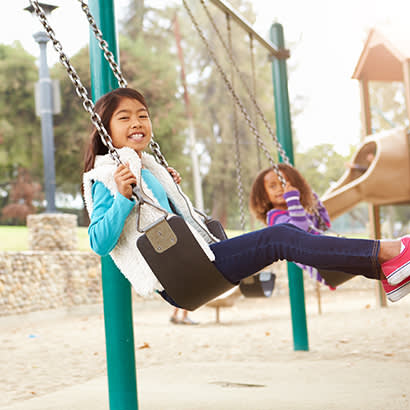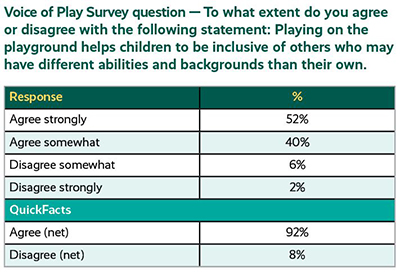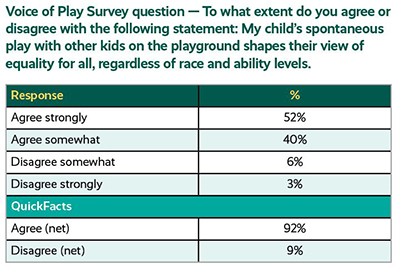
For an enhanced digital experience, read this story in the ezine.
A study by the International Playground Equipment Manufacturers Association exemplifies the importance of play
One incontrovertible fact about the effects of the coronavirus (COVID-19) pandemic has been that people across the United States have turned to parks and recreation areas for healthy outdoor physical activity and relief from the worries and pressures of the pandemic on them and their families.
While some agencies initially closed parts of their park systems due to health department mandates at the outset of the pandemic, health experts quickly realized that healthy outdoor activity should not only be permitted, but also is highly recommended for all ages.
Park administrators at the local, state and national level saw unprecedented increases in visitation on trails, in parks and throughout the outdoor spaces of their park and recreation systems. In some cases, the increased visitation overwhelmed their capacity. In Maryland, for example, rangers had to close 14 state parks 292 times in 2020, turning park visitors away because they had reached capacity by early morning or because park resources might be irreparably damaged by overuse. Some national parks, like Glacier in Montana and Rocky Mountain in Colorado, have attracted such overwhelming numbers of visitors that staff have instituted timed visitation hours or required reservations just to enter certain areas of the parks.
While the pandemic has imposed harsh economic and health costs on our nation, one positive net benefit has been that it has given families more time to spend together outdoors, especially visiting local parks and nearby recreation resources. The 2021 NRPA Engagement With Parks Report shows that 7 in 10 people increased or maintained their use of public parks and trails during the pandemic. A variety of factors during the pandemic enabled people to spend greater time outdoors and visiting parks. Some factors were that parents were spending less time in person at work and more time working remotely; most school districts shifted to online learning for students; and restrictions were imposed on many types of indoor entertainment activities — each of which led to significant increases in park visitation during the pandemic and use of local neighborhood parks and playgrounds.
Survey of Parents During the Pandemic Shows Vital Importance of Play
 In the summer of 2020, the International Playground Equipment Manufacturers Association (IPEMA), in cooperation with Wakefield Research, conducted a national survey of parents on the benefits of children’s play during the pandemic. This was the third in its well-regarded “Voice of Play” surveys and focused on the importance that parents placed on outdoor play during the pandemic, where and with whom children played, and what the benefits of play were during this time of the COVID-19 pandemic.
In the summer of 2020, the International Playground Equipment Manufacturers Association (IPEMA), in cooperation with Wakefield Research, conducted a national survey of parents on the benefits of children’s play during the pandemic. This was the third in its well-regarded “Voice of Play” surveys and focused on the importance that parents placed on outdoor play during the pandemic, where and with whom children played, and what the benefits of play were during this time of the COVID-19 pandemic.
Tom Norquist, senior vice president of innovation and business development at PlayCore and twice president of IPEMA, says that the formation of IPEMA, a nonprofit association formed by the play equipment industry, was an effort to establish an independent third-party organization to verify that play equipment was meeting industry standards for safety, quality and durability. But IPEMA, Norquist says, wanted to be about more than just serving trade and manufacturers’ interests. “We established the Voice of Play initiative to identify the benefits of play to society at large and specifically call out the physical, mental and health benefits of play for children,” Norquist explains. He adds that an important element of the Voice of Play initiative is also to foster inclusiveness in play design and promote equity in play for all.
Early in the pandemic, when public agencies were very concerned about “theater hygiene” — the cleaning of surfaces and fear that the SARS-CoV-2 virus was transmissible through direct contact with hard surfaces — park agencies across the country largely closed play areas and playgrounds to the public. Parental concern was extremely high, and the 2020 IPEMA survey results showed 50 percent of parents did not feel comfortable allowing their children to play on play equipment in public playgrounds. But as epidemiological knowledge of the virus expanded, restrictions on public use of playgrounds and play equipment were relaxed and use of playgrounds dramatically increased.
One of the enduring questions about how the COVID-19 pandemic has affected children over the past months is what effect it has had on children’s capacity for play. To understand the impacts on play, it is useful to first ask a few questions on the relative importance of public playgrounds in communities, especially in vulnerable communities where often there are few opportunities for children to play safely.
Playgrounds as Social Determinants of Health
For years, there has been great interest by academic researchers and health professionals in quantifying the relationship that parks, school playgrounds and other recreation resources in neighborhoods and communities have on influencing the health and well-being of children — and for that matter, the health and well-being of parents and caregivers as well. The influence of public recreation spaces and other aspects of the built environment within communities and early childhood development are often included in the categories of social determinants of health.
Definition of the categories of social determinants of health vary, but they invariably include the conditions of the environments where people are born, live, work, play and age. These social determinants of health include access to quality education, access to quality healthcare, access to healthy food, the social context of where people live, environmental factors, access to transportation, and the impact of the built environment on individuals and communities. Dr. Michael Suk, systemwide chair of the Geisinger Hospital system’s Musculoskeletal Institute in Pennsylvania and board member of the American Medical Association, says that playgrounds play a critical role as social determinants of health. “Access to parks and playgrounds is extremely important in children’s health and development,” he says.
Further, the existence, location and access to playgrounds, both public and private, have a bearing on the quantity and quality of play that kids can engage in. Answering the question of whether playgrounds are a social determinant of health, Allison Colman, NRPA’s director of health, says, “Absolutely they are. Having access to quality playspaces and playgrounds gives children the health benefits of being physically active, a way to develop motor skills, a place to improve mental health, and they contribute to the overall health outcomes of a community.” It is not just access to built playgrounds and natural environment playspaces, she says, but also the connection to social resources and social capital of the community. “Playgrounds build social cohesion,” Colman contends.
The Impact of the Pandemic on Children’s Play
Has the pandemic affected children’s play? Play experts and park and recreation professionals say it has without question. Norma García, director of the County of Los Angeles Department of Parks and Recreation, says that once early pandemic stay-at-home orders were relaxed, visitation to their parks and playgrounds increased nearly 300 percent. “We saw that our parks became places for refuge, respite and physical activity. Parents told us that they felt that our parks were the only place they felt safe taking their kids.”
García says that they completely closed their playgrounds early in the pandemic because of a public health order by the county. “We were inundated with calls. When we finally opened them, it was like every neighborhood had their own Disneyland. Play is so vital to the health of children.”
Elizabeth Cushing, CEO of Playworks, a nonprofit that works nationally with school systems on developing play, says, “We definitely saw how the pandemic affected children’s play. For many months, kids’ access to play was very limited. Children were cut off from play with others and the amount of time they could play daily was limited. Not only were they deprived of the physical activity, but they could not get the social benefits of play either.”
Norquist agrees that kids lost out, but he believes that the closure of playgrounds in the early stages of the pandemic made children and parents appreciate being outdoors so much more than they did before. “People want to be outside,” he says. “The pandemic enabled families to be outdoors together. In doing so, it rekindled how much fun it was to play together. And, families realized once again how great their local parks are.”
Suk agrees that the pandemic has led to a greater appreciation of outdoor play. The pandemic significantly increased social isolation and inactivity for kids, he says. “Access to playgrounds and nature playspaces has a deeply positive effect on children’s physical and mental health,” Suk notes.
The Role of Playgrounds in Promoting Diversity, Equity and Inclusion
Playgrounds in parks, schoolyards and other public places are trusted public spaces. They are some of the few places that children can meet others unlike them, including children of different races, ethnicities and religious backgrounds, to allow children to engage in unstructured spontaneous play. For kids, playgrounds are equivalent to the “public square” for adults — that is, places where all may freely express themselves.
Many play experts and park and recreation professionals attest to the inclusive nature of play and the need for playgrounds to be inclusive. García says, “When children are playing together, they don’t see race or ethnicity or disability.”
The Voice of Play survey by IPEMA asked two important questions of parents regarding how playgrounds make their kids more tolerant and inclusive. Parents were asked if they agreed with this statement: “Playing on the playground helps children to be inclusive of others who may have different abilities and backgrounds than their own.” More than 90 percent of parents surveyed agreed strongly or somewhat with the statement see chart above).
Parents were also asked how much they agreed with this statement: “My child’s spontaneous play with other kids on the playground shapes their view of equality for all, regardless of race and ability levels.” Again, greater than 90 percent agreed strongly or somewhat with the statement (see chart below).
 “Play evokes empathy,” Norquist says, quoting Dr. Stuart Brown, founder of the National Institute for Play. Brown believes play is instrumental in discovering the full potential in everyone. Norquist says that play is the great equalizer and that the inclusive design of playgrounds will help foster a welcoming environment for all kids, as well as build tolerance and acceptance of differences. García agrees: “Play really does transcend differences in race, ethnicity and gender. It creates a means for youth to connect with each other and themselves. It is where children find commonality.”
“Play evokes empathy,” Norquist says, quoting Dr. Stuart Brown, founder of the National Institute for Play. Brown believes play is instrumental in discovering the full potential in everyone. Norquist says that play is the great equalizer and that the inclusive design of playgrounds will help foster a welcoming environment for all kids, as well as build tolerance and acceptance of differences. García agrees: “Play really does transcend differences in race, ethnicity and gender. It creates a means for youth to connect with each other and themselves. It is where children find commonality.”
Colman notes that an important consideration is to identify the gaps where children and communities don’t have access to quality parks and playspaces. In Los Angeles County, García says that her team definitely saw the impacts of a lack of public playgrounds, especially in poorer communities and communities of color where children had few opportunities for play. In April 2021, they instituted a campaign, called Everybody Play, to encourage people to get outside and play in parks. They partnered with the county’s youth employment department to hire youth to work in the program and had 31,000 participants in two months.
For those in urban areas who live more than a 10-minute walk from playgrounds or have other access barriers, finding quality spaces for children to play and engage in physical activity is both a community challenge and a matter of equity. Children in vulnerable communities, Colman emphasizes, are most at risk. There needs to be more focus on equitable park access generally, especially for those that have been most burdened by inequities. “Intentionally engaging all community members must be part of the conversation,” Colman says.
Moving Beyond the Pandemic
The importance parents place on their children’s health was demonstrated in many ways during the pandemic. This concern is not just the physical health of children, but also their mental health and sense of well-being. Nearly 9 in 10 parents in the IPEMA survey agreed that play is more important than ever.
Even though playgrounds have one of the highest rates of inspection and attention to safety of any park spaces, the increased amount of inspections and new protocols for disinfecting and cleaning play equipment have set a new standard of attention for playgrounds. Many park professionals see this trend continuing. Norquist agrees that the very high level of concern for safety during the pandemic will result in a net benefit for all because there are so many more eyes on playspaces and making parks and playgrounds cleaner and safer. “People are much more aware of the conditions and safety of playgrounds now,” he says.
Although climate change is not a cause nor an effect that is directly related to the pandemic, the effects of climate change will have a considerable impact on the design of playgrounds and playspaces in the future. In the West and Southwest, as in many other areas of the country, extreme heat is an increasing factor inhibiting outdoor play. Shade is not only desirable for playgrounds, but also serves an essential need — as children simply will not be able to play in playgrounds during the middle of the day without it.
The City of Phoenix has embarked on a major test of cool pavement surfaces in a variety of locations throughout the city.
Jennifer Vanos, an assistant professor in the School of Sustainability at Arizona State University, is part of a research team studying the effects of the cool pavements. She says thinking that cool pavement surfacing will be an improvement is an incorrect assumption. “Reflected solar radiation when kids are using a playground at midday may actually make conditions worse because the temperature is hotter and the radiation greater since it is also reflected from the surface.” She says a better solution is to “re-naturalize” playgrounds and playspaces by adding natural elements, such as trees, vegetation and grass, which will reduce ambient temperatures and provide cleaner air.
The environments our children play in are as important as the equipment on which they play. Shade, clean water, clean air and safe places to play were a legacy left to adults, and they must be a part of the legacy we leave to the next generations. COVID-19 is, at the same time, a test of our capability to weather the challenges of the pandemic and a call to action to learn from the challenge and pass on that knowledge gained to generations that follow ours.
The response to the pandemic by park and recreation agencies in service to the public is well documented and explained in NRPA’s extensive report, COVID-19 and Parks and Recreation: Response and Recovery.
Richard Dolesh is NRPA’s retired Vice President of Strategic Initiatives and Editor-at-Large for Parks & Recreation magazine.

